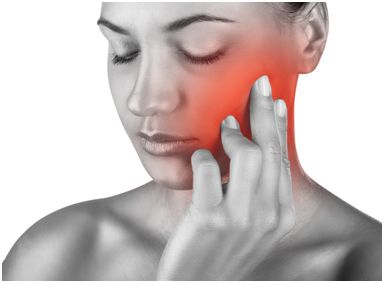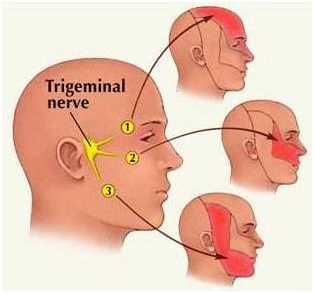Trigeminal neuralgia (TN), also known as tic douloureux, is a distinctive facial pain syndrome that may become recurrent and chronic.
It is a chronic pain condition that affects the trigeminal nerve, which carries sensation from your face to your brain.
If you have trigeminal neuralgia, even mild stimulation of your face — such as from brushing your teeth or putting on makeup — may trigger a jolt of excruciating pain.

Trigeminal neuralgia
Symptoms
Trigeminal neuralgia symptoms may include one or more of these patterns:
- Occasional twinges of mild pain.
- Episodes of severe, shooting or jabbing pain that may feel like an electric shock.
- Spontaneous attacks of pain or attacks triggered by things such as touching the face, chewing, speaking and brushing teeth.
- Bouts of pain lasting from a few seconds to several seconds.
- Episodes of several attacks lasting days, weeks, months or longer — some people have periods when they experience no pain.
- Pain in areas supplied by the trigeminal nerve, including the cheek, jaw, teeth, gums, lips, or less often the eye and forehead.
- Pain affecting one side of your face at a time.
- Pain focused in one spot or spread in a wider pattern.
- Attacks becoming more frequent and intense over time.
Causes of Trigeminal Neuralgia
In trigeminal neuralgia, the trigeminal nerve’s function is disrupted.
- Usually, the problem is contact between a normal blood vessel — in this case, an artery or a vein — and the trigeminal nerve, at the base of your brain. This contact puts pressure on the nerve and causes it to malfunction.
- Result of aging.
- It can be related to multiple sclerosis or a similar disorder that damages the myelin sheath protecting certain nerves.
Less commonly, trigeminal neuralgia can be caused by
- A tumour compressing the trigeminal nerve.
- A brain lesion or other abnormalities.
In other cases, a cause can’t be found.

Triggers
A variety of triggers may set off the pain of trigeminal neuralgia, including:
- Shaving
- Stroking your face
- Eating
- Drinking
- Brushing your teeth
- Talking
- Putting on makeup
- Encountering a breeze
- Smiling
- Washing your face
Diagnosis
Your doctor will diagnose trigeminal neuralgia mainly based on your description of the pain, including:
Type
Pain related to trigeminal neuralgia is sudden, shock-like and brief.
Location
The parts of your face that are affected by pain will tell your doctor if the trigeminal nerve is involved.
Triggers
Trigeminal neuralgia-related pain usually is brought on by light stimulation of your cheeks, such as from eating, talking or even encountering a cool breeze.
Tests such as neurological examination and Magnetic resonance imaging (MRI) may be required to make accurate diagnosis of trigeminal neuralgia and determine underlying causes for your condition.
Treatment
Trigeminal neuralgia treatment usually starts with medications, and many people require no additional treatment. However, over time, some people with the condition may stop responding to medications, or they may experience unpleasant side effects. For those people, injections or surgery provide other trigeminal neuralgia treatment options.
Low Level Laser Therapy Treatment for Trigeminal Neuralgia
Low Level Laser Therapy (LLLT) is the application of red and near infrared light over injuries to stimulate cellular repair. LLLT has a powerful anti-inflammatory effect as well as a healing effect.
Clinical studies of the effects of LLLT on injured nerves have revealed
- An increase in nerve function and improved capacity for myelin production.
- LLLT has been shown to be effective for promoting axonal growth in injured nerves.
The main benefit of LLLT is that it is relatively non-invasive and has the ability to treat nerve injuries without surgical intervention thus making it a desirable treatment option.
LLLT appears to be a highly effective modality in treating intractable facial pain as seen with trigeminal neuralgia.
LLLT has no known side effects, is safe and effective.

